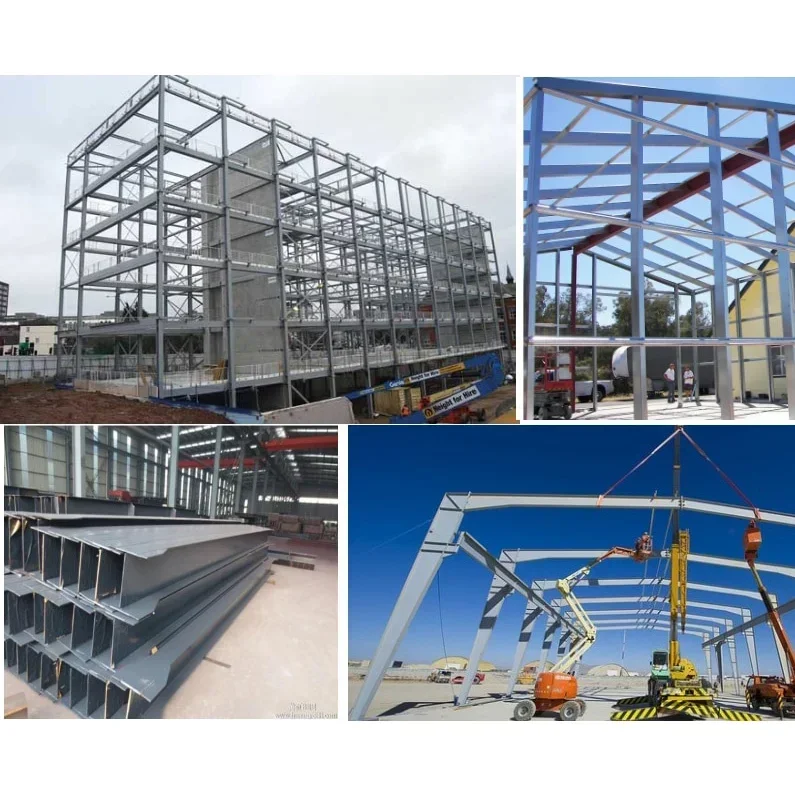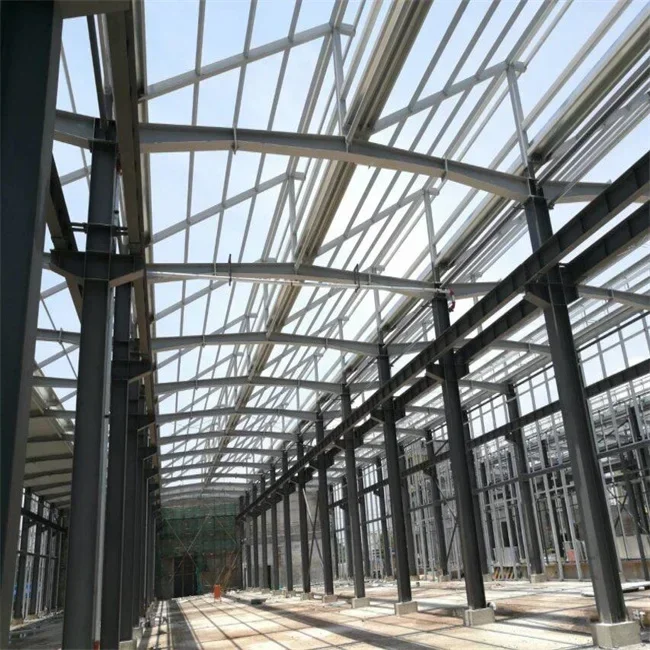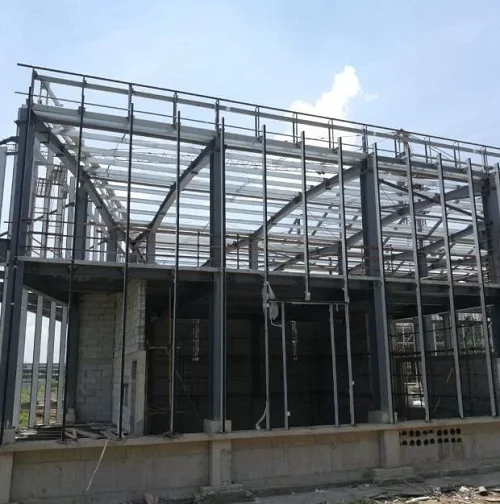-
-
What are the advantages of choosing steel workshop buildings?
-
What design considerations should be kept in mind for steel frame workshops?
-
What is the construction process like for steel workshop buildings?
-
How is the structural design of single-story steel workshops different from multi-story ones?
-
Discover the key elements of a steel frame structure workshop in this insightful guide. From its robust construction to its versatile applications, learn how these workshops offer durability and flexibility for various industrial needs. Explore the benefits of utilizing steel frames, such as cost-effectiveness and sustainability, making them a popular choice among builders and manufacturers alike. Dive into the design aspects that contribute to the efficiency and functionality of steel frame workshops, ensuring optimal workspace utilization and structural integrity. Uncover essential considerations when planning or constructing a steel frame structure workshop to maximize its potential and longevity.
Advantages of Steel Workshop Buildings
Durability and Strength
Steel frame structures are known for their high durability and strength, ensuring long-lasting workshop buildings. These structures can withstand various external factors such as weather conditions, pests, and fire. The robust nature of steel makes it an ideal choice for constructing workshops that need to stand the test of time.
Steel's innate strength provides a sturdy framework for workshop buildings, offering stability and reliability in the long run. Unlike other construction materials, steel does not warp or expand due to environmental changes, maintaining its structural integrity over time.
Cost-Effectiveness
One of the significant advantages of opting for a steel frame structure workshop is its cost-effectiveness compared to traditional construction methods. Steel is relatively inexpensive compared to materials like wood or concrete. The construction process with steel is quicker, reducing labor costs and overall project expenses.
The cost-effectiveness extends beyond the initial construction phase; steel buildings require minimal maintenance over their lifespan. With little upkeep needed, owners save on repair and renovation costs in the long term.
Design Considerations for Steel Frame Workshops
Optimal Layout
Efficient workflow in a steel frame structure workshop is crucial. Placing workstations strategically can enhance productivity. For example, locating heavy machinery near the entrance facilitates easy loading and unloading.
Creating designated areas for specific tasks streamlines operations. Separating cutting, welding, and assembly stations minimizes confusion and optimizes workflow. Ensuring ample space between workstations prevents congestion and promotes safety.
-
Efficient workflow enhances productivity
-
Designated areas streamline operations
Natural Lighting and Ventilation
Incorporating natural lighting into the steel frame workshop reduces energy costs while enhancing the working environment. Skylights or large windows allow ample sunlight to illuminate the workspace during daylight hours.
Ventilation systems are essential to maintain air quality within the workshop. Installing vents or fans helps regulate temperature and remove fumes generated during welding processes. Proper ventilation ensures a safe and comfortable working environment for employees.
-
Natural lighting reduces energy costs
-
Ventilation systems maintain air quality
Flexibility in Design
Designing a steel frame workshop with future expansions in mind is advantageous. Using modular construction techniques allows for easy expansion when needed without disrupting current operations.
Opting for flexible layouts that can accommodate additional machinery or workstations enables seamless growth over time. Incorporating adjustable features like removable partitions provides versatility to adapt to changing needs without major renovations.
-
Modular construction allows for easy expansion
-
Flexible layouts accommodate future growth
Customizable Steel Workshop Designs
Exterior Finishes
Steel frame structure workshops offer a variety of exterior finishes and colors, allowing customization to match aesthetic preferences. From bold reds to sleek grays, the options are vast. This customization ensures that the workshop not only serves its purpose but also complements its surroundings.
The ability to choose from different exterior finishes enables workshop owners to create a space that reflects their style and brand identity. For example, a tech startup may opt for a modern look with metallic finishes, while a woodworking shop might prefer earthy tones for a rustic feel.
Interior Customization
In addition to exterior options, steel workshops provide interior customization possibilities. Owners can work with the design team to plan layouts that suit their specific needs. Whether it's adding windows for natural light, doors for easy access, or skylights for ventilation, these features enhance functionality within the workspace.
Moreover, interior customization extends beyond aesthetics to practicality. Specialized equipment or storage requirements can be accommodated through tailored designs. For instance, an automotive workshop may need hoists and tool storage solutions integrated into the layout for efficient operations.
Construction Process of Steel Workshop Buildings
Efficient Construction
Steel frame structure workshops boast efficient and quick construction processes. This is attributed to the use of pre-engineered components that are fabricated off-site, reducing assembly time significantly. The prefabricated steel components are designed with precision, ensuring a seamless fit during construction.
The utilization of advanced technology, such as computer modeling, plays a crucial role in the efficient construction process. Through precise measurements and accurate fabrication, the steel components can be produced to exact specifications before being transported to the site for assembly. This advanced approach minimizes errors and speeds up the overall construction timeline.
Minimal Site Disruption
During the assembly of steel frame structure workshops, there is minimal site disruption compared to traditional construction methods. The prefabricated steel components arrive ready for installation, reducing on-site cutting and production activities significantly. As a result, noise levels and waste generation at the construction site are notably lower.
Moreover, with precise measurements taken during the design phase using computer modeling software, each component fits seamlessly into place during assembly. This not only streamlines the construction process but also ensures that disruptions to surrounding areas are kept to a minimum throughout the building phase.
Structural Design of Single-Story Steel Workshops
Space Optimization
Steel frame structure workshops are typically designed as single-story buildings to maximize accessibility and space utilization. The clear span design of these structures allows for an open floor plan, providing ample room for various activities within the workshop. By eliminating the need for interior columns, the entire space can be utilized efficiently without any obstructions.
Single-story steel workshops offer a versatile layout where different areas like workstations, storage spaces, and machinery can be strategically organized for optimal workflow. With the absence of multiple floors, workers can move around the workshop with ease, enhancing productivity and safety. This design also facilitates the installation of overhead cranes or other heavy equipment due to its spacious and unobstructed layout.
-
Pros:
-
Maximizes usable space
-
Facilitates efficient workflow
-
Allows easy movement of equipment and machinery
-
Structural Stability
The structural components of steel frame workshops such as columns, beams, and trusses play a crucial role in providing stability to the building. These elements are designed to withstand various loads and forces while ensuring the overall integrity of the structure. Columns bear the vertical load from the roof and transfer it to the foundation, distributing weight evenly throughout the building.
Beams support the roof load transferred by columns, while trusses help in distributing this load further across a larger area. The integration of these components creates a robust framework that can withstand environmental factors like wind or snow loads. Steel structures have high bearing capacity compared to other materials, ensuring long-term durability and safety for occupants working inside.
-
Cons:
-
Initial cost might be higher than traditional structures
-
Requires specialized construction team for assembly
-
Limited flexibility in modifying structural layout once built

-
Benefits of Multi-Story Steel Workshops
Maximization
Building a multi-story steel frame structure workshop allows for the maximization of limited land area. By going vertical with multiple floors, businesses can make the most out of their property without expanding horizontally. This approach is especially beneficial in urban areas where land availability is scarce and expensive.
Businesses can construct additional floors to create more space for various operations while maintaining a smaller ground footprint. For example, a manufacturing company can have production facilities on one floor, administrative offices on another, and storage areas on yet another level. This zoning helps streamline processes and enhance overall efficiency.
Increased Floor Space
One of the key advantages of opting for a multi-story steel workshop is the increased floor space it offers compared to single-story structures. Businesses can significantly expand their usable area without compromising the structural integrity or stability of the building. This additional space provides room for growth, accommodating new equipment, workstations, or personnel as needed.
Moreover, having multiple levels enables businesses to segregate different functions or departments efficiently. For instance, retail shops could dedicate each floor to specific product categories or services, enhancing organization and customer experience. The flexibility in design and layout that multi-story steel workshops offer contributes to improved workflow and productivity.
Enhanced Functionality
Incorporating multiple floors in a steel frame structure workshop enhances functionality by allowing businesses to separate activities based on their requirements. For example:
-
Ground Floor: Manufacturing and production processes.
-
Second Floor: Administrative offices and meeting rooms.
-
Third Floor: Research and development facilities.
This segregation not only optimizes workflow but also creates a conducive environment for each type of operation within the same premises.
Maintenance of Metal Workshop Buildings
Low Maintenance Requirements
Steel frame structure workshops have low maintenance requirements due to steel's resistance to corrosion and wear. This durability reduces the need for frequent repairs or replacements, saving time and money. Regular inspections are essential to identify any potential issues early on, ensuring a longer lifespan for the building.
Regular inspections help in spotting any signs of wear or damage that may compromise the structure's integrity. By addressing these issues promptly, costly repairs can be avoided in the future. Routine checks allow for proactive maintenance measures to be implemented, further extending the workshop building's longevity.
Cleaning and Painting
To maintain both the appearance and longevity of a metal workshop building, regular cleaning and painting are necessary. Cleaning helps remove dirt, dust, and other debris that can accumulate over time, preventing them from causing damage or corrosion. Painting not only enhances the aesthetic appeal but also provides an additional layer of protection against environmental elements.
-
Pros:
-
Steel's durability reduces repair costs.
-
Regular inspections prevent major structural issues.
-
Cleaning and painting enhance appearance and longevity.
-
-
Cons:
-
Neglecting maintenance can lead to costly repairs.
-
Lack of regular checks may result in unnoticed damages.

-
Closing Thoughts
The comprehensive exploration of steel frame structure workshops sheds light on their numerous advantages, design considerations, customization options, construction processes, structural designs, benefits of multi-story setups, and maintenance requirements. These insights underscore the versatility, durability, and efficiency that steel buildings offer for various industrial and commercial applications.
For those considering steel workshop constructions, understanding the intricacies involved in design, construction, and maintenance is crucial for ensuring a successful project. By incorporating these factors into the planning phase, individuals can leverage the full potential of steel structures to create functional and sustainable workshop spaces. Embracing the principles highlighted in this discourse will undoubtedly lead to well-informed decisions and optimal outcomes in the realm of steel frame structure workshops.
Frequently Asked Questions
What are the advantages of choosing steel workshop buildings?
Steel workshop buildings offer durability, cost-effectiveness, and quick construction. They provide flexibility in design and can be easily customized to meet specific requirements.
What design considerations should be kept in mind for steel frame workshops?
Design considerations for steel frame workshops include structural integrity, load-bearing capacity, foundation requirements, and insulation needs to ensure a functional and efficient workspace.
How customizable are steel workshop designs?
Steel workshop designs are highly customizable, allowing for various sizes, layouts, finishes, and features to suit individual preferences and operational needs effectively.
What is the construction process like for steel workshop buildings?
The construction process involves site preparation, foundation installation, steel frame assembly, wall and roof installation, finishing touches such as doors and windows, followed by final inspections before occupancy.
How is the structural design of single-story steel workshops different from multi-story ones?
Single-story steel workshops have simpler structural requirements compared to multi-story buildings. Multi-story workshops need additional considerations for vertical load distribution and stability due to increased height.
Why is maintenance important for metal workshop buildings?
Regular maintenance ensures the longevity and safety of metal workshop buildings by addressing issues such as corrosion prevention, structural integrity checks, roof maintenance, and general upkeep to preserve their functionality over time.

